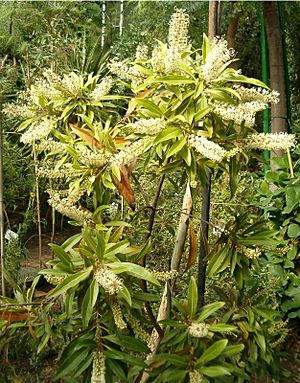Buckinghamia facts for kids
Quick facts for kids Buckinghamia |
|
|---|---|
 |
|
| Buckinghamia celsissima | |
| Scientific classification |
|
| Kingdom: | Plantae |
| Clade: | Tracheophytes |
| Clade: | Angiosperms |
| Clade: | Eudicots |
| Order: | Proteales |
| Family: | Proteaceae |
| Subfamily: | Grevilleoideae |
| Tribe: | Embothrieae |
| Subtribe: | Hakeinae |
| Genus: | Buckinghamia F.Muell |
| Species | |
|
See text |
|
Buckinghamia is a genus of only two types of trees. They belong to the plant family Proteaceae. These trees are found only in the rainforests of north-eastern Queensland, Australia. One species, the ivory curl flower (B. celsissima), is very popular. People grow it in gardens and parks across eastern and southern Australia. It's also used as a street tree in places like Brisbane. The second species, B. ferruginiflora, was discovered more recently in 1988.
Discovering Buckinghamia
The genus Buckinghamia was named in 1868. It was named by a scientist called Ferdinand von Mueller. He chose the name to honor Richard Grenville. He was the Duke of Buckingham and a government official at the time.
Scientists first thought Buckinghamia was related to other plants like Grevillea. Later studies looked closely at its features. They also studied its chloroplasts, which are parts of plant cells. These studies showed that Buckinghamia is indeed closely related to Grevillea. It is also related to Opisthiolepis and Hakea.
Types of Buckinghamia Trees
There are two known species of Buckinghamia trees:
- Buckinghamia celsissima (also called ivory curl flower or spotted silky oak)
- Buckinghamia ferruginiflora (also called Noah's Oak or Spotted Oak)
Ivory Curl Flower
The Buckinghamia celsissima, or ivory curl flower, is a beautiful tree. In gardens, it usually grows up to about 10 meters (33 feet) tall. In its natural rainforest home, it can reach about 30 meters (98 feet) tall.
Its leaves are shiny and dark green. Some leaves are lobed, meaning they have rounded sections. Others are smooth. New leaves often have a pretty pink color. In summer, these trees put on a spectacular show. They have long, hanging sprays of creamy-white flowers. These flowers are also sweetly fragrant.
In a garden, the ivory curl flower can grow in sunny or partly shaded spots. It attracts birds and bees, which helps with pollination. These tough and beautiful trees are great for creating privacy screens or blocking wind.
People have been growing B. celsissima in gardens for over 100 years. You can find old, well-established trees in famous places. These include the botanic gardens in Adelaide, Melbourne, Sydney, and Brisbane. They are very popular in parks and gardens along the coast of eastern and southern Australia. They have a long history of being planted as street trees in Brisbane.
In the wild, B. celsissima trees grow in tropical rainforests. They are found in north-eastern Queensland. They usually grow at altitudes between 200 and 1,000 meters (656 to 3,281 feet).
Noah's Oak
Buckinghamia ferruginiflora, also known as Noah's Oak or Spotted Oak, is another rainforest tree. It can grow up to about 30 meters (98 feet) tall in nature.
Scientists only officially recognized this species in 1988. It was described by Don Foreman and Bernie Hyland. This tree is found only in a small part of the Daintree Rainforest. It grows in thick tropical rainforests. You can find it from sea level up to about 350 meters (1,148 feet) in altitude.
B. ferruginiflora has some unique features. Its young branches are often hairy. Its leaves are usually 9 to 20 cm (3.5 to 7.9 inches) long. They are 2 to 6 cm (0.8 to 2.4 inches) wide. The buds, new shoots, and flower parts are covered in dense, rusty-colored hairs. Its flower clusters are 8 to 20 cm (3.1 to 7.9 inches) long. The individual flowers are creamy brown. They also have those rusty hairs on the outside. The styles, which are part of the flower, are shorter than those of B. celsissima. Its fruits are like small pods, about 2 to 2.5 cm (0.8 to 1 inch) long. The seeds inside are flat and have a small wing.
Because B. ferruginiflora grows in such a small area, it is considered "near threatened." This means it needs protection to make sure it continues to thrive. The Queensland government officially lists it under the Nature Conservation Act 1992.
See also
 In Spanish: Buckinghamia para niños
In Spanish: Buckinghamia para niños

